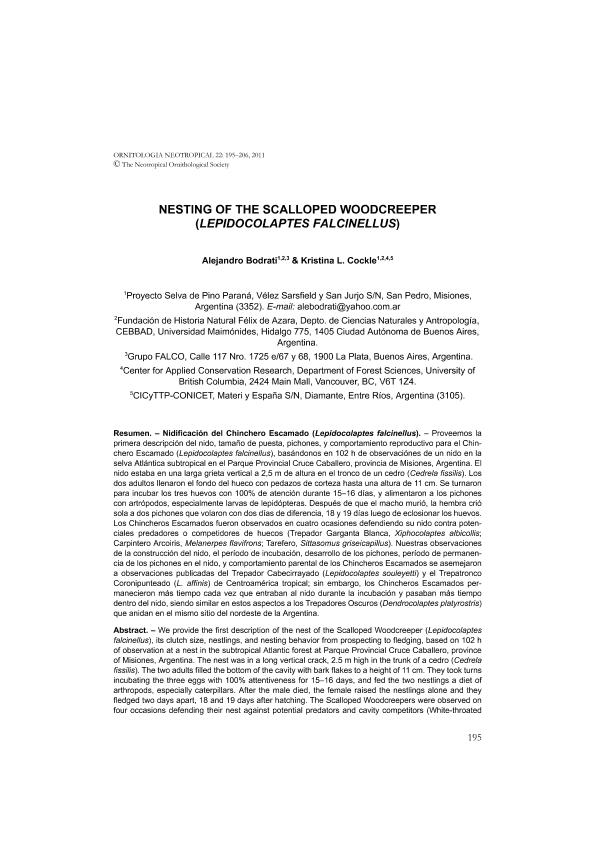Artículo
We provide the first description of the nest of the Scalloped Woodcreeper (Lepidocolaptes falcinellus), its clutch size, nestlings, and nesting behavior from prospecting to fledging, based on 102 h of observation at a nest in the subtropical Atlantic forest at Parque Provincial Cruce Caballero, province of Misiones, Argentina. The nest was in a long vertical crack, 2.5 m high in the trunk of a cedro (Cedrela fissilis). The two adults filled the bottom of the cavity with bark flakes to a height of 11 cm. They took turns incubating the three eggs with 100% attentiveness for 15 to 16 days, and fed the two nestlings a diet of arthropods, especially caterpillars. After the male died, the female raised the nestlings alone and they fledged two days apart, 18 and 19 days after hatching. The Scalloped Woodcreepers were observed on four occasions defending their nest against potential predators and cavity competitors (White-throated Woodcreeper, Xiphocolaptes albicollis; Yellow-fronted Woodpecker, Melanerpes flavifrons; Olivaceous Woodcreeper, Sittasomus griseicapillus). Our observations of nest construction, incubation period, nestling development, nestling period, and parental behavior for Scalloped Woodcreepers were similar to published observations for Streak-headed Woodcreepers (Lepidocolaptes souleyetti) and Spot-crowned Woodcreepers (L. affinis) of tropical Central America; however, Scalloped Woodcreepers had longer bouts on the nest and higher nest-attentiveness during incubation, and in these characteristics were similar to Planalto Woodcreepers (Dendrocolaptes platyrostris) that breed at the same site in northeastern Argentina. We provide the first description of the nest of the Scalloped Woodcreeper (Lepidocolaptes falcinellus), its clutch size, nestlings, and nesting behavior from prospecting to fledging, based on 102 h of observation at a nest in the subtropical Atlantic forest at Parque Provincial Cruce Caballero, province of Misiones, Argentina. The nest was in a long vertical crack, 2.5 m high in the trunk of a cedro (Cedrela fissilis). The two adults filled the bottom of the cavity with bark flakes to a height of 11 cm. They took turns incubating the three eggs with 100% attentiveness for 15–16 days, and fed the two nestlings a diet of arthropods, especially caterpillars. After the male died, the female raised the nestlings alone and they fledged two days apart, 18 and 19 days after hatching. The Scalloped Woodcreepers were observed on four occasions defending their nest against potential predators and cavity competitors (White-throated Woodcreeper, Xiphocolaptes albicollis; Yellow-fronted Woodpecker, Melanerpes flavifrons; Olivaceous Woodcreeper, Sittasomus griseicapillus). Our observations of nest construction, incubation period, nestling development, nestling period, and parental behavior for Scalloped Woodcreepers were similar to published observations for Streak-headed Woodcreepers (Lepidocolaptes souleyetti) and Spot-crowned Woodcreepers (L. affinis) of tropical Central America; however, Scalloped Woodcreepers had longer bouts on the nest and higher nest-attentiveness during incubation, and in these characteristics were similar to Planalto Woodcreepers (Dendrocolaptes platyrostris) that breed at the same site in northeastern Argentina.
Nesting of the Scalloped Woodcreeper (Lepidocolaptes falcinellus)
Título:
Nidificación del Chinchero Escamado (Lepidocolaptes falcinellus)
Fecha de publicación:
06/2011
Editorial:
Neotropical Ornithological Society
Revista:
Ornitología Neotropical
ISSN:
1075-4377
Idioma:
Inglés
Tipo de recurso:
Artículo publicado
Clasificación temática:
Resumen
Archivos asociados
Licencia
Identificadores
Colecciones
Articulos(CICYTTP)
Articulos de CENTRO DE INV.CIENT.Y TRANSFERENCIA TEC A LA PROD
Articulos de CENTRO DE INV.CIENT.Y TRANSFERENCIA TEC A LA PROD
Citación
Bodrati, Alejandro; Cockle, Kristina Louise; Nesting of the Scalloped Woodcreeper (Lepidocolaptes falcinellus); Neotropical Ornithological Society; Ornitología Neotropical; 22; 6-2011; 195-206
Compartir




